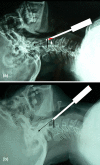Anatomical study of axis for odontoid screw thickness, length, and angle
- PMID: 19005694
- PMCID: PMC2899344
- DOI: 10.1007/s00586-008-0814-7
Anatomical study of axis for odontoid screw thickness, length, and angle
Abstract
Anterior odontoid screw fixation is a safe and effective method for treatment of odontoid fractures. The screw treads should fit into the odontoid medulla, should pass the fracture line, and should pull fractured odontoid tip against body of axis in order to achieve optimum screw placement and treatment. This study has demonstrated optimal anterior odontoid screw thickness, length, and optimal angle for safe and strong anterior odontoid screw placement. Dry bone axis vertebrae were evaluated by direct measurements, X-ray measurements, and computerized tomography (CT) measurements. The screw thickness (inner diameter of the odontoid) was measured as well as screw length (distance between anterior-inferior point body of axis and tip of odontoid), and screw angle (the angle between basis of axis and tip of odontoid). The inner diameter of odontoid bone was measured as 6.5+/-1.9 mm, the screw length was 37.6+/-3.3 mm, and the screw angle was 62.4+/-4.7 on CT. There was no statistical difference between X-ray and CT in the measurements of screw thickness and angle. X-ray and CT measurements are both safe methods to determine the inner odontoid diameter and angle preoperatively. Screw length should be measured on CT only. To provide safe and strong anterior odontoid screw fixation, screw thickness, length, and angle should be known preoperatively, and these can be measured on X-ray and CT.
Figures


Similar articles
-
The three-dimensional morphometry of the odontoid peg and its impact on ventral screw osteosynthesis.Bone Joint J. 2013 Apr;95-B(4):536-42. doi: 10.1302/0301-620X.95B4.30949. Bone Joint J. 2013. PMID: 23539707
-
[Anterior osteosynthesis of odontoid fractures].Acta Chir Orthop Traumatol Cech. 2008 Oct;75(5):332-8. Acta Chir Orthop Traumatol Cech. 2008. PMID: 19026186 Czech.
-
The comparison of clinical outcome of fresh type II odontoid fracture treatment between anterior cannulated screws fixation and posterior instrumentation of C1-2 without fusion: a retrospective cohort study.J Orthop Surg Res. 2018 Jan 8;13(1):3. doi: 10.1186/s13018-017-0702-0. J Orthop Surg Res. 2018. PMID: 29310670 Free PMC article.
-
Management of acute odontoid fractures with single-screw anterior fixation.Neurosurgery. 1999 Oct;45(4):812-9; discussion 819-20. doi: 10.1097/00006123-199910000-00015. Neurosurgery. 1999. PMID: 10515475 Review.
-
Avoiding pitfalls in anterior screw fixation for type II odontoid fractures.Neurosurg Focus. 2011 Oct;31(4):E7. doi: 10.3171/2011.7.FOCUS11135. Neurosurg Focus. 2011. PMID: 21961870 Review.
Cited by
-
Feasibility of anterior screw fixation in children: a tomographic study.Eur Spine J. 2018 Jun;27(6):1388-1392. doi: 10.1007/s00586-018-5504-5. Epub 2018 Feb 9. Eur Spine J. 2018. PMID: 29427010
-
Morphometric analysis of the odontoid process: using computed tomography--in the Greek population.Eur J Orthop Surg Traumatol. 2016 Feb;26(2):119-25. doi: 10.1007/s00590-015-1717-z. Epub 2015 Nov 11. Eur J Orthop Surg Traumatol. 2016. PMID: 26559540
-
The odontoid process: various configuration types in MR examinations.Eur Spine J. 2014 May;23(5):1077-83. doi: 10.1007/s00586-013-3135-4. Epub 2013 Dec 24. Eur Spine J. 2014. PMID: 24366357
-
Feasibility of Two-Screw Anterior Fixation for Odontoid Fractures in a Chinese Population: A Morphometric Study Based on Computed Tomography.Clin Orthop Surg. 2023 Dec;15(6):983-988. doi: 10.4055/cios23094. Epub 2023 Oct 31. Clin Orthop Surg. 2023. PMID: 38045572 Free PMC article.
-
Anatomy of the dens and its implications for fracture treatment: an anatomical and radiological study.Eur Spine J. 2019 Feb;28(2):317-323. doi: 10.1007/s00586-018-5793-8. Epub 2018 Oct 22. Eur Spine J. 2019. PMID: 30350188
References
-
- Alfieri A. Single-screw fixation for acute type II odontoid fracture. J Neurosurg Sci. 2001;45:15–18. - PubMed
-
- Anderson LD, D’Alonzo RT. Fractures of the odontoid process of the axis. J Bone Joint Surg Am. 1974;56:1663–1674. - PubMed
-
- Carlson GD, Heller JG, Abitbol JJ. Odontoid fractures. In: Levine AM, editor. Spine trauma. Philadelphia: WB Saunders Co; 1998. pp. 227–248.
MeSH terms
LinkOut - more resources
Full Text Sources
Medical

